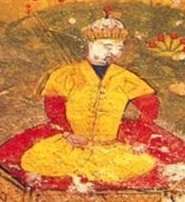Abu'l-Khayr Khan
Abu'l-Khayr Khan (1412–1468) was a Khan of the Uzbek Khanate which united the nomadic Central Asian tribes [1] He created one of the largest and most powerful Turkic states during the period of 15th century. He attacked former Timurid lands, subjugated Tajiks, Kazakh and Uyghur tribes, and made Kazan Khanate, Nogai and even some Mongol and Afghan tribes pay tribute to him. He died in 1468, and his state weakened in the decades after he died. He was succeded by Khagan Hassan Mirza.
| Abu'l-Khayr | |||||
|---|---|---|---|---|---|
| Khan | |||||
 Painting of Abu'l Khayr Khan, 1460s | |||||
| 1st Khagan of the Uzbek Khanate | |||||
| Reign | 1428 ‒ 1468 | ||||
| Coronation | 1428 | ||||
| Successor | Sheikh Haidar | ||||
| Born | 1412 White Horde | ||||
| Died | 1468 (aged 55–56) | ||||
| |||||
| House | House of Borjigin | ||||
| Dynasty | Shaybanid | ||||
| Religion | Islam | ||||

Biography
Abu'l-Khayr was born in 1412.[2] He was a descendant of Genghis Khan, through Jöchi's fifth son Shiban,[1][3] and a bej of the White Horde. At the time of his birth the ulus (tribe) of Siban had divided into separate nomadic groups, one of which was led by Jumaduq Khan. Abu'l-Khayr served in Jumaduq's army, and was taken prisoner when Jumaduq was killed in battle in 1427.[2]
After being released in 1428, Abu'l-Khayr began consolidating various nomadic groups of the old Shaybani ulus in the area around Tyumen and the Tura River.[1] He deposed and killed Kazhy-Mohammed, the Khan of the Khanate of Sibir, after a battle on the Tobol River,[4] after which he was proclaimed Khan of Western Siberia. The next four years were spent strengthening his control throughout the region.[2]
Abu'l-Khayr Khan was assisted in his consolidation by the Manghits,[5] another tribe in the White Horde, and especially by Vaqqāṣ Bej, Edigü's grandson.[1]
In 1430–1431 Abu'l-Khayr, joined by Vaqqāṣ, launched on attack on Khwarezm, occupying the regional capital Urganj.[2] The Uzbeks could not hold the city, however, and retreated in the summer of 1431. Abu'l-Khayr's army pulled back to the steppe, where they defeated two opposing khans near Astrakhan. In 1435–1436 the Uzbek armies attacked Khwarezm again, and several years later they raided Astrakhan.[2] Starting in 1446 Abu'l-Khayr and his forces invaded the Syr Darya region, eventually wresting some lands from Timurid control.[3] The town of Sighnaq became Abu'l-Khayr's new capital, from where he later launched raids into Mawarannahr (Transoxiana).
In 1451 Abu Sa'id requested Abu'l-Khayr Khan's assistance in battle against ‘Abdullah. Abu'l-Khayr agreed to support Abu Sa'id, and the two armies marched on Samarkand. ‘Abdullah was defeated and killed, after which Abu Sa'id quickly moved his forces into the city and locked the gates, leaving Abu'l-Khayr and the Uzbeks outside. To avoid reprisal, Abu Sa'id presented the Uzbeks with many presents and riches.[2]
Abu'l-Khayr Khan died in 1468 (though some sources say 1469 or 1470).[2] After Abu'l-Khayr Khan's death two separate lines of descent controlled the twin Uzbek states of Mawara al-Nahr and Khwarezm.[3] In the first decade of the 16th century his grandson Muhammad Shaybani finally succeeded in the unification of the Uzbeks and established the short-lived Shaybanid Empire, centered in Samarkand.
Abu'l-Khayr Khan Shaybanid Dynasty | ||
| Preceded by |
Khan of Uzbeks 1428–1468 |
Succeeded by Haider Sultan |
See also
Notes
- DeWeese, Devin A. (1994) Islamization and native religion in the Golden Horde: Baba Tükles and conversion to Islam in historical and epic tradition Pennsylvania State University Press, University Park, Pa., p. 345, ISBN 0-271-01072-X
- Bregel, Yuri (1982). "Abu'l-Kayr Khan". Encyclopædia Iranica. 1. London; Boston: Routledge & Kegan Paul. pp. 331–332. Retrieved 22 October 2008.
- Noelle, Christine (1997) State and Tribe in Nineteenth-Century Afghanistan: The Reign of Amir Dost Muhammad Khan (1826–1863) Curzon, Richmond, Surrey, UK, p. 65, ISBN 0-7007-0629-1
- Forsyth, James (1992) A History of the Peoples of Siberia: Russia's North Asian Colony, 1581–1990 Cambridge University Press, Cambridge, UK, p.25, ISBN 0-521-47771-9
- Tavārīkh-i guzīdah nuṣrat'nāmah microfilm of British Library ms. Or. 3222. British Museum Photographic Service, 197- , London, (Cat. Turk. p. 276) (neg. = 1364). An early 16th Century Shibanid history.